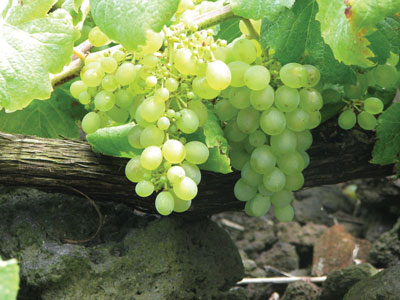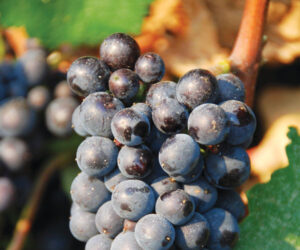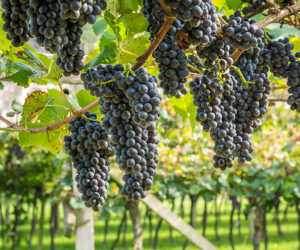 Verdelho is referred to as one of the noble varieties and its history goes back to at least the 15th century. This white grape varietal has alleged origins in Sicily, but what is confusing in its lineage is the presence of two similarly named varietals: Verdejo and Verdello. All three of these names are also sometimes confused with a fourth grape variety, Gouveio.
Verdelho is referred to as one of the noble varieties and its history goes back to at least the 15th century. This white grape varietal has alleged origins in Sicily, but what is confusing in its lineage is the presence of two similarly named varietals: Verdejo and Verdello. All three of these names are also sometimes confused with a fourth grape variety, Gouveio.
Tracing grape varieties has never been easy; the most definitive studies are highly sophisticated involving DNA testing and analysis. But in the case of Verdelho, this data does not yet exist, therefore we rely on written history. Gouveio is generally accepted as the same varietal, and this is what some of the Verdelho present in the Douro region of Portugal is referred to. In Spain, Verdejo and Verdello are present. Verdejo is better known in the Rueda region, just upstream of the Portuguese Douro region on the Douro River, and Verdello is in the Galicia region, just to the north of Porto, Portugal, where the river enters the Atlantic Ocean. The confusing part of the Rueda region is that they state Verdejo has origins in North Africa! Out in the Atlantic, Verdejo is the most widely planted grape on the island archipelago of Madeira, an autonomous region of Portugal. Plantings are also present in Australia, Argentina, California, France and Italy, and the wines are marketed as a blend or as Verdelho itself. Within the Iberian Peninsula though, it is safe to say that the regions are relatively close to each other, and it is entirely possible that they are all one and the same. Safe, that is, but not definitive. We’ll leave that up to the researchers and the bloggers.
The climates where the varietal is grown are generally hot, with the exception of the Galicia. As expected, we see different wine styles in each region, resulting from local tradition or happenstance, but this lends the additional term of versatility to this variety. The grape is made into dry wines as well as Port styles served slightly chilled or on ice.
Speaking of notable wine styles, as mentioned previously, Verdelho is the most widely planted grape on the Portuguese island of Madeira. The grape was introduced there in the mid-15th century shortly after the islands were colonized. Other varietals grown on the islands are Sercial, Malmsey (also known as Malvasia Bianca) and Bual. The wines of Madeira were well respected and many a ship stopped there to stock up for journeys around the world. The island group also lends its name to the style of wine we know as Madeira.
Madeira, the style that is, is a fortified sweet wine that came about by accident, and can be made from any of the region’s four varieties. In order of increasing sweetness, there is Sercial, which is relatively dry at 1-3 °Brix, Verdelho at 3-4.5 °Brix, Bual at 4.5-5.5 °Brix, and Malmsey, the sweetest, ranging from 6-11.5 °Brix. All the styles of Madeira are fortified, which came about as a result of the locals preserving their wines for journeys over the oceans.
Madeiras are also characteristically oxidized. The legend goes that the French and the British were often at war, thus essentially cutting off the Brits to the famous wine regions of Europe. The British thus became good friends with the Portuguese in order to have access to wine. Treaties were established and the two countries engaged in an active wine trade. As the British Empire expanded to India, the Brits made every effort to make sure that ships traveling around the Horn of Africa were well-stocked with wine for the colonists and troops overseas and Madeira was a convenient stop. The barrels of wine were stored deep in the holds of the ship and as the seas warmed in the equatorial latitudes, the wines were oxidized. It was not an intentional oxidation, but it could not be prevented in the days before air conditioning. Upon arrival at a destination port, the wines were off-loaded and processed into bottles. They were obviously oxidized, yet nonetheless very palatable. (I have to speculate when the destination port was even farther away from the great wine producing regions of the world than where the sailors came from that they were going to drink anything!) Alas, in the end, Madeira was a style that stuck even after the colonists and troops returned to England. In our modern-day absence of sailing ships, the style is produced under controlled conditions in a process called estufagem.
Estufagem involves exposing the wine to high temperatures, either by placing it in tanks and heating it, or in temperature-controlled rooms with either steam heat or a natural heat. Depending on the desired wine quality, the duration and temperature exposure is adjusted to match. The lower quality wines are heated in tanks for shorter periods of time at higher temperatures, say a few months at up to 130 °F (54 °C). The wines of the highest quality are placed in hot rooms, naturally heated by the sun, in some cases for more than 20 years. All the styles are exposed to oxygen. Go figure, everything we are taught as home winemakers — controlling temperature, headspace, sulfur dioxide and the like — all gets blown out of the water in the style of Madeira. In this case, oxidation is not considered a flaw, but rather a style. Much the same as that of sherries of Spain, this is another case where tradition, because of lack of control, led to a style.
We farm a very small block of Verdelho at UC-Davis, 42 vines total. Typical to the varietal, the berries are small with a high skin-to-juice ratio. Verdelho retains its acidity, even in our summer heat and, also typical to the varietal, the sugar levels can get fairly high, resulting in the possibility of relatively high alcohol levels. The grapes at maturity are aromatic and floral. I have read that they can be herbaceous, but I would expect that only in cooler growing climates. The characteristics of the grape are sometimes difficult to discern because of the many possible wine styles.
I make these wines in a dry white, malolactic negative style. Those familiar with my writing know that this is the style of white I prefer to make. My preference is to try to accentuate varietal character of the grape. Given the long history of Verdelho, no matter the name, it is no doubt that there have been countless renditions in style, and many come about as a result of tradition, which is to be respected.
There are two main contributing factors to making Verdelho wine in the style I prefer; yeast and acid. We’ll tackle the latter first. While I mentioned that the grape retains its acidity, that is relatively speaking. In warmer climates, some acid supplement is necessary. The grapes generally come in at a pH around 3.8 and an acid of 0.55 g/100 mL. In my climate, other white grapes will come in with much higher pH values and lower acids, thus requiring a considerable acid supplement. With respect to Verdelho, a cursory glance tells us that the numbers are not bad, and would probably be a nice wine if left alone. But I like a little crispness so I target to taste my whites with an acid level around 0.65; the pH irrespective of that. Therefore I generally supplement with about a 1 g/L addition of tartaric acid at the crusher and call it good.
Now let’s consider the yeast. Hopefully you have read about some of the designer yeasts available because with respect to this varietal, this can make a difference. I have done yeast trials with Verdelho and have found that the yeast QA23 (Lalvin) is the choice for me. Independent of the product literature, I found that this yeast fermented the most aromatic, clean, citrus-based flavors. Unbeknownst to me at the time was that this strain was a Portuguese isolate, but I could not find any reference to it being used with Verdelho; only with Vinho Verde, which is almost 180 degrees opposite in wine style.
Alas, we have come across a grape varietal with obscure roots and not much familiarity, but with a long history in the New and Old World. So I ask you, if we don’t know the variety, then is it really familiar? The apparent answer is no, but I am sure we can always recognize the most familiar styles; Madeira and white Port, and the drier styles of Argentina and Australia. Needless to say, Verdelho is a grape with great flexibility and variability in winemaking.
Verdelho Recipe
(yield: 5 gal/19 L)
Ingredients
• 100 lbs. (45 kg) Verdelho fruit or 6 gallons (23 L) juice
• Distilled water
• 10% potassium metabisulfite (KMBS) solution: Weigh 10 grams of KMBS, dissolve into about 75 milliliters (mL) of distilled water. When completely dissolved, make up to 100 mL total with distilled water.
• 5 grams Lallemand QA23 yeast or 5 grams Premier Cuvée
• 5 grams Fermaid K (or equivalent yeast nutrient)
• 5 grams Di-ammonium Phosphate (DAP)
• Tartaric acid
Other equipment or needs
• 5-gallon (19-L) carboy
• 6-gallon (23-L) carboy
• 6-gallon (23-L) plastic bucket
• Racking hoses
• Inert gas (nitrogen, argon or carbon dioxide will do)
• Refrigerator (~45 °F/7 °C) to cold settle the juice.
• Ability to maintain a fermentation temperature of 55 °F (13 °C).
• Thermometer capable of measuring between 40-110 °F (4-43 °C) in one degree increments
• Pipettes with the ability to add in increments of 1 milliliter
• Clinitest® tablets
• Ability to test or have testing performed for sulfur dioxide
Step by step
1. Crush and press the grapes. Do not delay between crushing and pressing. Move the must directly to the press and press lightly to avoid extended contact with the skins and seeds.
2. Transfer the juice to a 6-gallon (23-L) bucket. During the transfer, add 20 milliliters of 10% KMBS solution (The equivalent of 50 ppm SO2).
3. Move the juice to the refrigerator.
4. Take a sample to test for acidity and pH.
5. Let the juice settle at least overnight. Layer the headspace with inert gas and keep covered.
6. When sufficiently settled, rack the juice off of the solids into the 5-gallon (19-L) carboy. If there is headspace in the carboy, layer with inert gas.
7. Dissolve the DAP in as little distilled water required to completely go into solution (usually ~20 mL).
8. Adjust the acid to 0.65 g/100 mL using tartaric acid. Starting Brix is 23 °B. Use bench trials to adjust your sugar levels.
9. Prepare yeast. Heat about 50 mL distilled water to 104 °F (40 °C). Do not exceed this temperature as you will kill the yeast. The end result is you want 50 mL of water at 104 °F (40 °C). Sprinkle the yeast on the surface of the heated water and gently mix so that no clumps exist. Let sit for 15 minutes undisturbed. Measure the temperature of the yeast suspension and the juice. You do not want to add the yeast to your cool juice if the difference in temperatures of the yeast and must exceeds 15 °F (8 °C). Acclimate your yeast by taking about 10 mL of the cold juice and adding it to the yeast suspension. Wait 15 minutes and measure the temperature again. Do this until you are within the specified temperature range.
10. You should see signs of fermentation within two to three days. If the fermentation has not started by day four, you might consider warming the juice to 60-65 °F (16-18 °C) temporarily to stimulate the yeast. Once the fermentation starts, move back to the lower temperature. If that does not work, consider re-pitching the yeast as described above.
11. Normally you would monitor the progress of the fermentation by measuring Brix. One of the biggest problems with making white wine at home is maintaining a clean fermentation. Entering the carboy to measure the sugar can infect the fermentation with undesirable microbes. So at this point, the presence of noticeable fermentation is good enough.
12. Two to three days after the onset of fermentation, mix up the Fermaid K according to the directions in about 50 mL of boiled water (to sterilize it so you can add it to the juice). Leave the wine alone for about two weeks.
13. If the fermentation has progressed, then after about two weeks start measuring the sugar. Sanitize your thief; remove just enough liquid for your hydrometer. Record your results. If the Brix is greater than 7 °Brix wait another week before measuring. If the Brix is less than 7 °Brix begin measuring every other day. When the Brix is about 2 °Brix add 7 mL of the 10% KMBS solution (this addition is the equivalent to 20 ppm SO2).
14. Continue to measure the Brix every other day until you have two readings in a row that are negative and about the same. This should be -1.5 °Brix or lower for a dry wine.
15. Measure the residual sugar using the Clinitest® tablets and the kit instructions. If the wine is dry, that being about 0.2% or less, add another 7 mL of 10% KMBS solution (20 ppm) and begin to lower the temperature to about 40 °F (4 °C).
16. Taste the wine. If the wine smells good, then let the lees settle for about two weeks and stir them up. Repeat this every two weeks for eight weeks. 17. After the second stir, check the SO2 and adjust to 30–35 ppm free. After eight weeks, let the lees settle. At this point, the wine is going to be crystal clear or a little cloudy. If the wine is cloudy, then presumably, if you have kept up with the SO2 additions and adjustments, temperature control, kept a sanitary environment, and there is no visible sign of a re-fermentation, then this is most likely a protein haze. You can clarify the haze with bentonite if you wish.
18. While aging, test for SO2 and keep maintained at 30-35 ppm or at the level recommended for the wine’s pH, but do not exceed 45 ppm.
19. Once the wine is cleared it is time to bottle. This will be about six months after the onset of fermentation. Keep in mind this wine has had the malolactic fermentation MLF inhibited. If all has gone well to this point, given the quantity made, it can probably be bottled without filtration.







